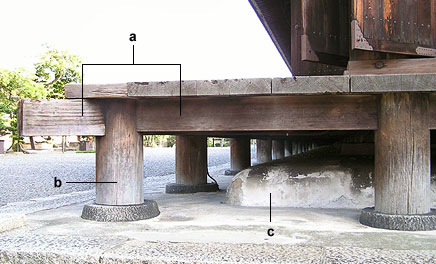|
||
 |
||

@
(C)2001 Japanese Architecture and Art Net Users System.@No reproduction or republication without written permission.
fÚÌeLXgEÊ^ECXgÈÇASÄÌRec̳f¡»E]ÚðֶܷB
|
||||||
| @ | ||||||
| enzuka@© | ||||||
| KEY WORD :@architecture / general terms | ||||||
| @ | ||||||
| Also written entanbashira Z, also pronounced entsuka. Struts *tsuka ©, placed on base stones, enzuka soseki ©bÎ, to support the veranda frame *engamachi y in the kure-en Ò, which has long planks running parallel to the wall. The kirime-en ØÚ (see *nure-en G), a veranda with floorboards placed at a right angle to the wall, has tie beams *enkazura , inserted into the struts to form the framework. Corner struts are called sumienzuka ÷©. Struts are attached to the base stones by a tenon *hozo Ù¼ inserted into a mortise *hozoana Ù¼, or they are simply set on top of the base stone and held there by the weight of the entire framework. Veranda posts and struts are usually made of the same kind of hard wood. The struts are generally square. Round ones are rare and said to be older than square struts. | ||||||
| @ | ||||||
 |
||||||
@ |
||||||
| REFERENCES: | ||||||
| @ | ||||||
| EXTERNAL LINKS: | ||||||
| @@ | ||||||
| NOTES: | ||||||
| @ | ||||||
(C)2001 Japanese Architecture and Art Net Users System.@No reproduction or republication without written permission. fÚÌeLXgEÊ^ECXgÈÇASÄÌRec̳f¡»E]ÚðֶܷB |
||||||
| @ |